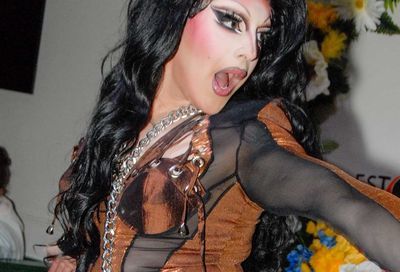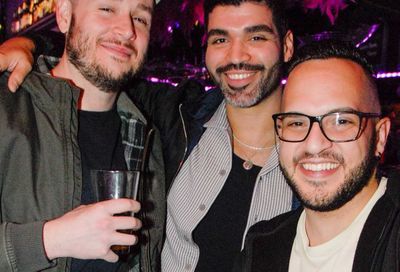Good Taste
As the longtime restaurant critic for The Washington Post, Tom Sietsema has turned dining out into a fabulous -- and enviable -- lifestyle.

Photo by Todd Franson
MW: David Hagedorn, the chef who used to run Trumpets, once got a bad review in the Post, from Phyllis. I said, “Doesn’t that hurt business?” And he said, “No. A bad review can be just as good as a good one because it gets people in the door to try it.” Is that your experience?
SIETSEMA: [Laughs.] Clearly, they’re just looking at the pictures. I think a major publication is going to have an impact on a restaurant, good or bad. A major establishment has the power to get a lot of business or take away a lot of business, so I take that to heart. I feel very responsible about it. But my end obligation is to the reader. We all work hard for our money and it’s not as if a lot of restaurants are offering preview prices while they get the kinks worked out.
On the other hand, I am sort of sympathetic to restaurants, too, in that the profit margins are very low for most. And while everyone else is having fun, you’re working Christmas, Easter, Mother’s Day, weekends, Saturdays. But my ultimate job responsibility is to the reader, the consumer. I’m not paid to be a cheerleader for the chefs.
MW: To the best of your knowledge, have you ever closed a restaurant with a review?
SIETSEMA: Bad restaurants close themselves. But restaurants have closed after negative reviews. The one that comes to mind is Le Pigalle — 18th Street, French. I tried it four times. One time, I went with my most optimistic of friends. We had this horrible meal. I knew I was going to pan it and give it a poor rating and he looked at me and said, “At least the water is cold.” I used that as the headline. The restaurant didn’t last too much longer after that.
MW: Are there critic-proof restaurants?
SIETSEMA: There are some restaurants that are really bad that have location to their advantage and then they thrive.
MW: Such as?
SIETSEMA: Lauriol Plaza.
MW: But they make their own tortilla chips!
SIETSEMA: [Their success] baffles me — you really have to hunt to find good food there. It just reminds me that food isn’t everything. Ambiance and decor and alcohol — strong drinks — are pretty seductive details in a restaurant.
MW: Are there instances where a restaurant that may not have been doing so well has benefitted tremendously from a good review by you?
SIETSEMA: I think any restaurant critic will tell you that the most fun is when you find an exceptional “mom and pop” that not that many people know about and that is doing really good work, and you can sort of shine a light on them. Those don’t happen too often: One, if it’s really good people are going to find out; and, two, it’s really hard to keep secrets anymore thanks to the Internet. Phyllis was able to sit on interesting finds for a long time, because she was pretty much it aside from The Washingtonian back in the day. But now if there’s a great little restaurant in the hinterland, people discover it pretty quickly.
MW: What do you look for overall in a restaurant?
SIETSEMA: Food is of primary importance to me, but increasingly, comfort is an issue, how loud or soft the music is, the lighting, what to look at both in terms of the interior and the people. Gathering people around the table sometimes trumps just food. I do try and find one or two dishes that warrant your going there. My job is to sort of eat through the range of a menu and evaluate it from that. But, increasingly, restaurants are playgrounds. That’s where we go to socialize.
Service is important, too. People are much more forgiving of mediocre food than they are when they feel they have not been paid attention to or pampered or somehow made to feel at home. Even the best food doesn’t taste quite as good if you’ve got sour service.
MW: Unless it’s intended. Some places actually seem to encourage sour service.
SIETSEMA: That’s a bad business decision.
MW: You’ve been doing this for 14 years. How do you stay anonymous?
SIETSEMA: It’s really hard. I do know they have pictures of me, some quite old, in kitchens around town. Managers move around, waiters move around from restaurant to restaurant. I guess the advantage I have is I go three or four times to a restaurant before I write about it in the magazine, and on one of those visits they won’t know me. I will never make a reservation in my name.
In restaurants, they’re so savvy that they have my numbers, they have my friends’ numbers. They have my Open Table accounts — and I have like 20 Open Table accounts. I have 10 different credit cards in different names. I have to be changing these things to keep up with technology, and mixing it up so that they don’t know that I’m coming in. I kill off pseudonyms at a faster rate than I did 10 years ago.
MW: How does a pseudonym get a credit card?
SIETSEMA: It was a lot easier before 9/11, let me tell you that. But if you pay your bills they don’t mind so much. It’s sort of like I have a small business with people working for me. And I pay my bills.
MW: Do you think you get better food than the Average Joe if they recognize you?
SIETSEMA: A million things can be changed for you if you’re identified or flagged as a restaurant critic. You get a better table. You’ll get a goofy waiter and the manager will walk by and, all of the sudden, goofy waiter gone, best waiter in. Or the owner or general manager will start to wait on you. And I notice that there are lags in the courses as they’re fussing over a plate for me. This is what also happens: The waitress will turn into the handsome waiter, as if I’m so foolish that I’m going to change my opinion on a restaurant based on whether I get a male or female waiter. I think that’s kind of amusing.
MW: When did you come out to the public?
SIETSEMA: If people didn’t know last year, they would have found out when I did a piece on the importance of home entertaining, and I threw a dinner party and my partner was mentioned in that. I didn’t really come out come out or try to be in the closet or anything. But I think that the less people know about me, the better, regardless whether it’s my age or my height or my weight or my personal preferences in things, because I just want them to imagine me as their trusty friend who gets out a lot more than they do, telling them where they should go eat or what they should avoid. I always want to be that person. If people know what I looked like, or people know too much about me, it might change the way they read a review.
MW: Gays are often considered by the general population as guideposts of culture, of good taste. Think Queer Eye for the Straight Guy. Do you think that when your straight readers found out you were gay that elevated the perception of your reviews in their eyes, made them even more authoritative?
SIETSEMA: That’s an interesting question — I hadn’t even though of that. I would hope that that’s not the case, because I don’t think that just because you’re gay that makes you more of a tastemaker. It’s a stereotype.
MW: Sure, it’s a stereotype — I’m living proof of a gay man without a shred of style or refined taste. But it’s nonetheless a stereotype held by the straight community and perpetuated, to some extent, by the media. I’m just curious if their perception of your opinions is altered when they find out you’re gay. “Oh, he must know what he’s talking about because” —
SIETSEMA: — he doesn’t have kids, he travels a lot, he’s eaten in Paris and Istanbul. [Laughs.]
I can see where that could be the perception, and as I mentally go around the country, there are quite a few gay food critics, past and present. I mean Craig Claiborne famously was gay, semi-closeted. James Beard was gay. I have at least a half a dozen major friends in the business who are gay and in important food positions, so I think it’s like fashion or the movies or any of those creative enterprises. It draws us in.
MW: What’s a typical day like for you?
SIETSEMA: Wow. Every day is a little different. My partner is a manager at the postal service headquarters. We are both early risers, and this goes against everything as very often I’ll get home at 9 or 10 o’clock at night. I love early dinners because it gives me some semblance of having a little time off.
I always try to have a good breakfast. I know it’s very old fashioned, but it’s the one meal I can control during the day and I’m like a little kid — I have the same thing. It’s almost always either Grape Nuts or oatmeal with bananas or strawberry, because I just want something that’s healthful. The rest of the day is all whatever I happen to be eating. And that’s the trick with this job. People say, “I’d love to have that job, it’s the best job.” But you have to eat things that aren’t necessarily to your taste. This job is all about transcending personal taste. When I’m working on the Fall Dining Guide, I go to about 100 restaurants starting in May and June for publication in October, so I’m thinking fall. I’m not eating watermelon and rhubarb and soft-shell crabs. I’m looking for haunches of meat and heavier things knowing that this is going to appear in print in October.
I have to eat the fried chicken with the skin on and the dressing on the salad. You can’t be a picky eater — you have to be open to a broad range of tastes. There are very few things that I don’t particularly care for, so that’s not really a problem for me. It’s also important that my friends be open, too. I have a hardcore group of maybe 40 or 50 people that I eat out with. They know the drill. They know we’re gonna discreetly share foods. We will have to get certain things. But within that group I also have friends who are vegetarians or gluten intolerant or whatever, and that comes in handy, too, because we can pose special requests to a restaurant and see how they deal with it.
I try to go out with people who are much older than I am. I try and go with people who are younger. I go out with couples, single people and families, young families, all of whom bring something different to the table. I don’t really care what they think about the food, necessarily, but I like to gauge their reactions to the restaurants in general.
MW: Do you have a lunch and dinner out every day?
SIETSEMA: Almost every day, yeah. Right now I’m working on the Spring Dining Guide, so tonight I’m going to have two dinners. I’ll schedule one early and one later, just because I have to fit all these things in.
MW: What’s the trick to eating this much food?
SIETSEMA: Not eating most of it actually. A lot of the food I encounter is not very good, so, like, what’s the point? It’s all about pacing, too. I’m very good at cutting things up and making it look like I’ve eaten the food when in fact I haven’t. I gave up my membership in the “Clean Plate Club” years ago.
MW: Though I’ve agreed not to say specifically what you look like, I think most people would say, “My God, how do you stay so trim?”
SIETSEMA: You know what I do? At the office I have a fruit bowl so if I come back from lunch and it wasn’t very good, I’ll have an apple or tangerine or a banana. Or I’m really big on nuts, like raw almonds and things like that. They’re so filling, but I have my vices. My partner — he likes junk food. He likes good food too, but he’s always buying things that tempt me. I have a weakness for Doritos and Fritos and that sort of thing so he tries to keep those things hidden from me in the house.
MW: I keep buying Bugles.
SIETSEMA: Bugles!
MW: It’s like eating corn-flavored cardboard. I can’t stop myself. How’s your cholesterol?
SIETSEMA: A little higher than it should be but not bad. I worry about that because my father had heart disease. The day I got this job, I hired a personal trainer. I know that sounds like an affectation, but for me it’s like health insurance. So I work out with a trainer twice a week and then I try to do cardio on my own. This year, because so much of my job takes me out at night, my partner and I try and get one long walk in a day. It’s just a nice thing to do, to sort of reconnect. And also it has nothing to do with either of our jobs. Because this can be really intrusive, this job. I mean so much of our social life, so much of my life, is spent at a table. I spend an average of 40 hours at a table — that’s not writing time, that’s not researching, that’s at a table.
I think it’s the best job at The Washington Post. It’s not just a job, it’s a lifestyle, because it is all-consuming. There’s not a day that I’m not working, you know? And so you really have to love it. This is what separates the pros from the dilettantes, the people who think they want this job. You really have to enjoy restaurants and be up for it. Sure, there are nights when I would love to stay home in my sweats and eat a bowl of cereal. But you know what? I always get hungry again and I do think that one of the great things about this job is bringing people together at a table. I’m very lucky to eat with people who are interesting, and I’ve met a ton of interesting people.
It’s funny, this is a great job if you’re a single gay man, because you always need people to eat out with. It’s a great way to safely meet somebody over a meal. When I was first dating my partner, we’d be out walking on the street and someone would go, “Hey, Tom!” He’d say, “You know so many people,” and I’d say, “We just went on a review one time.”
MW: Is it fair to ask you what your favorite restaurant is?
SIETSEMA: It’s totally not fair. First of all, my favorite changes from week to week, from season to season, depends upon whether I’m eating alone or with somebody. But places where I would spend my own money right now — at this moment knowing that favorites change from day to day — are “Buck’s Fishing and Camping,” way up on Connecticut Ave. I like the lighting there. I like the fact that it’s simple, straightforward, mostly American food, but it’s done really, really well. I like the fact that the service is wonderful, they make great cocktails. And it’s right next to Politics and Prose, which is one of my favorite bookstores. That is a place where I would go off-duty.
I think Frank Ruta, the former White House chef, does a great job in his café, Palena. It’s up on Connecticut Ave. near the Uptown Theater. I like that a lot. I think when you’re around a lot of fancy stuff — and chefs will tell you this, too — you crave something that’s not so complex. I find real beauty in a stellar roast chicken or a great simple pasta carbonara or a great hamburger. If you make a good hamburger, there’s a reason why it’s a good hamburger. Like, are they grinding their meat fresh? What kind of meat is it? Are they toasting the bun? Are they making their own bun? Frank Ruta does that and Palena is a place that I like to take out-of-towners because it’s a nice little story to say, “Hey, the guy who’s making those big burgers used to cook for Nancy Reagan.” It’s a little, fun go-to place. I also love Iron Gate, which reopened across from the Tabard Inn on N Street. I think that’s a really nice place right now. But I have lots of favorites.
MW: If I were coming into Washington, only here for one night and budget is no option, is there a restaurant I should not miss?
SIETSEMA: Well, we’re an international community, we’re a world capital, and some of the best Indian cooking in the country is being done by Rasika and Rasika West End, two twin restaurants. I’ve been to India and I think it’s some of the most exciting Indian food I’ve had anywhere. What I love doing is taking people who swear that they really don’t like Indian, and it always changes their mind. It’s a really stellar dining experience. Indian food is my favorite food. I could eat it every day.
MW: On the flip side, what’s the one most overrated restaurant, one people should avoid?
SIETSEMA: That’s a good question. What should they avoid? I think Restaurant Nora is overrated. I think what [Chef Nora Pouillon] did early on in her career with organic food is really phenomenal, but I always feel like I paid way too much for way too much stuff on a plate. It might be organic, but it doesn’t necessarily make sense. And service hasn’t been that good there. And they need to re-do the dining room. But people always say, “Oooh, we went to Restaurant Nora.” I get it.
MW: Last question. Has being a restaurant critic changed the experience of eating out for you?
SIETSEMA: Well, I pinch myself every day because I get paid to do my hobby. I’ve also been covering restaurants since like the mid ’80’s, so I’m so used to it. I’m so used to wearing a suit. I’m so used to making reservations. I couldn’t imagine not doing it. I find great comfort in it. Most of my important life moments have taken place around a table. Some heated, some loving, hopefully more laughter than tears. But I think that bringing people around a table is one of the most important things you can do. And I get paid to do it. So I think I’m one of the luckiest guys to get paid to do it.
MW: So you’re not jaded towards food at all?
SIETSEMA: No. Every once in a while you want to take a little pulse check, but I love the fact that I can still be surprised by a new dish or delighted by something. There’s lots of travel I want to do, too. There’s lots of stuff to cover. I am never, ever, ever bored in this job. There are parts that are certainly a lot less fun than people might expect. Making 60 reservations a month, or all the extraneous details that people don’t think about, but I am never ever bored. And you always get hungry again.
Tom Sietsema’s reviews appear every Sunday in The Washington Post Magazine. Every Wednesday, starting at 11 a.m., he takes reader questions and comments for an hour in a live chat. Visit washingtonpost.com/pb/tom-sietsema.
Support Metro Weekly’s Journalism
These are challenging times for news organizations. And yet it’s crucial we stay active and provide vital resources and information to both our local readers and the world. So won’t you please take a moment and consider supporting Metro Weekly with a membership? For as little as $5 a month, you can help ensure Metro Weekly magazine and MetroWeekly.com remain free, viable resources as we provide the best, most diverse, culturally-resonant LGBTQ coverage in both the D.C. region and around the world. Memberships come with exclusive perks and discounts, your own personal digital delivery of each week’s magazine (and an archive), access to our Member's Lounge when it launches this fall, and exclusive members-only items like Metro Weekly Membership Mugs and Tote Bags! Check out all our membership levels here and please join us today!























